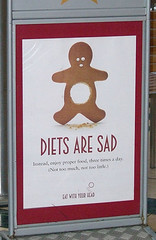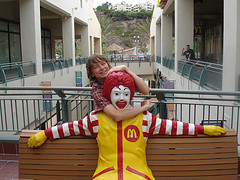4. Paco is following a low-fat diet
Click on the photograph and listen to the song. Notice the verbs in the Present Simple and those in the Present Continuous tenses.
|
|
As you have noticed we use the Present Simple and the Present Continuous tenses for completely different things. However, both are Present Tenses.
Have a look at the presentation on the left to clearly see the differences in form and uses of these two important tenses in English.
Remember that practising a lot is one of the best ways to improve your English.
- That being so, you will find more exercises to distinguish when to use these two tenses here.
- And click here if you want to complete a short passage instead of sentences.
Paco is following a low-fat diet. He is training hard because he has a football championship in Badajoz. Let's have a look at his eating habits and what he is eating now to keep fit for the competition.

|
| By Skwishy. C. Commons |
Usually, Paco (eat) anything he (want) to and (not worry) about what it does to his body. However, now, he (compete) in football and he (have) to change his eating habits.
Usually, he (get) up and (have) orange juice or justskips breakfast because he (be) late for class. Then at lunch, he frequently (meet) Andrés and some other friends at a bar and they (have) a sandwich, fries and a drink.
At dinner time, he always down (sit) with his family, and (enjoy) a big meal. His mother usually (serve) meat, vegetables and some potatoes. Most evenings, by ten o'clock, he (be) hungry again, so he (have) a big glass of milk and cookies.
Now, he (play) football competitively and his diet (be) completely different. These days, he (eat) a lot more protein, eggs and bacon, and carbohydrate in the mornings. So, he has more energy for his morning work-out. He (spend) noontime with his basketball teammates, not his "junk food" friends. He is following a low-fat, high-protein diet.
Now, at dinner, he (take) an extra helping of meat and potatoes. In fact, his mother (have) trouble keeping enough food in the refrigerator. She (think) that he is an eating-machine. Next, week Paco (go) to Badajoz for the Regional Football Championship. He is excited about it, but he (know) that it may take a while until they (win)< a big competition.
Do you know that there are more than 1 billion overweight adults in the world? And that 300 million of them are obese?
 |
| By Adam S. C. Commons |
According to the World Health Organization (WHO) overweight and obesity pose a major risk for chronic diseases, including type 2 diabetes,
cardiovascular disease, hypertension and stroke, and certain forms of
cancer. Experts tend to agree that the key causes are increased consumption of energy-dense foods high in saturated fats and sugars, and reduced physical activity. The health consequences range from increased risk of premature death,
to serious chronic conditions that reduce the overall quality of life.
Of especial concern is the increasing incidence of child obesity. More and more often, children stop doing physical activity and spend long hours in front of the television or the computer. In Australia, for example, children are becoming so fat that they need bigger booster seats to keep them safe in the car.

By Ondra Soukup . C. Commons
Among the fattest countries in the world, we find the United States of America, which was in the 9th position in 2007 (Spain was in position 83). In his book Fat Land: How Americans Became the Fattest People in the World (Boston, MA: Houghton Mifflin Co., 2003), Greg Critser assures that the problems began with Earl Butz, a former Secretary of Agriculture to Richard Nixon whose brief was to produce cheaper food. From then on, Ronald McDonald has become the second-most instantly recognised figure to children after Santa Claus.